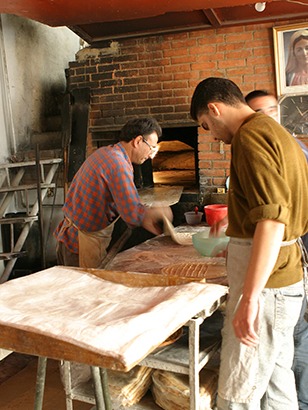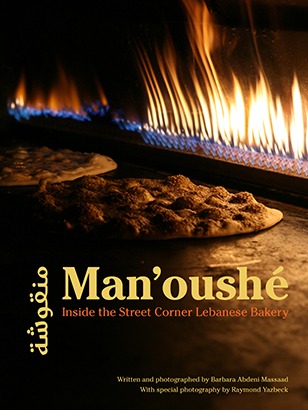Food writer Barbara Abdeni Masaad takes a closer look at the tradition of the manouche, the so-called Lebanese pizza. Be sure to look out for this local delicacy as you travel through the country.
“Bedeh manouche a3 zaouak” translates from Arabic “I want a manouche made to your liking.” This is what you may hear customers shouting out when entering a bakery to ask the ma3lem (baker) for a manouche. This portrays the Lebanese lifestyle and the adventurous characters of our people. Don’t get me wrong. The extreme opposite exists among us too. I’ve often met Lebanese ladies who bring their own toppings to the bakery because they feel that theirs is the original one, “el assliyeh”. They boast that they personally gathered and picked the zaatar (oregano) during its season and that the kalta (mixture) is a family secret.

I am a traveler and have often reflected upon different societies and how each one lives in their given community. The street corner Lebanese bakery, “the furn” is a meeting place where one can relish for a minimal price the iconic Lebanese breakfast par excellence. Don’t be fooled though, the “the furn” is not only about eating. It is much more than that. It is a meeting place where women gather to gossip, thus the saying “neswen el furn”. It is a place where one goes to talk politics or discuss a neighbor’s spat, and even to find true love. How would I know, I have sat and observed for many years the happenings of this special place. I have made my own humble conclusion: the manouche is the common denominator amongst us as Lebanese. It is available to the rich, to the poor, to all our diversified communities all around the country, and yet regional differences arise in recipes …
Traveling down south, one can visit local bakeries and eat the region’s typical bread called jreesh. This bread, sometimes called Ramadan bread, is served wrapped in newspaper. As the fresh loaf comes out of the hot baker’s oven a faint odor of misk and aniseed hangs in the air. The taste is out of this world. One bite and you are hooked for life.
In Beirut, man’oushé and all its varieties can be found at every corner. Local restaurants marketing the man’oushé as a meal make customers pay more for the same pie that is available at a nearby bakery. However, some favor sitting in chic surroundings to eat their manouche, it’s a question of taste. Menus with a huge variety of toppings like zaatar, cheese, red pepper paste mixed with onions, sujuk (Armenian sausages), eggs, kishk (dried yogurt) and many others including sweet varieties hinting at western pancake flavors, attract customers.
In the Shouf, manouche is made with wild herbs and plants, which grow in the region. When folded into a triangle they are called fatayer. Another regional favorite is made with kishk mixed with walnuts and a mild red pepper paste with chopped onions.
In Byblos bakeries make man’oushé with eggs, often mixed with awarma (preserved lamb meat made in the mountains) or sujuk. In the north, due to proper animal breading, laham bi ajin is favored. Sometimes you can find bakeries that solely make meat pies and offer no other varieties, not even zaatar. The meat is full fat, but the taste is exquisite, almost refined.
I am a traveler. I have wandered all around the world. When I smell the taste of zaatar cooking in a hot oven on fluffy, almost cakey dough, walking through the streets of Beirut, it hits me like a ton of bricks. I am back in Lebanon, in the village of my ancestors. I am Lebanese. I am home.
Man’oushé: Inside the Street
Corner Lebanese Bakery.
- Contact: +961 3 688 258
- barbaramassaad.com
Article edited on November 13,2021
Loading


